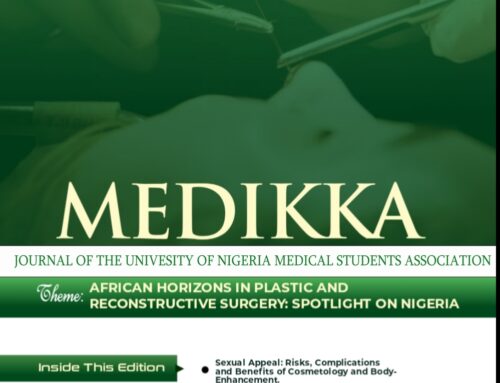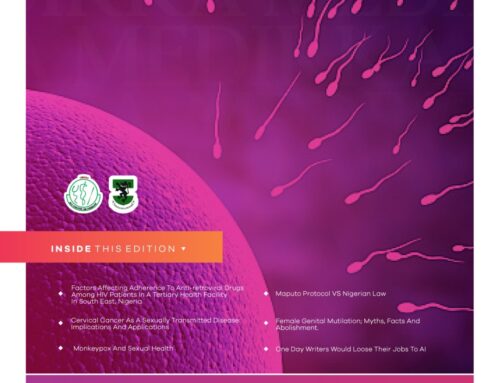in an urban area of eastern Nigeria. A total of 173 women aged between 40 and 60 years were selected by simple random
sampling and studied with the help of an interviewer-administered questionnaire. Majority of the respondents 141 (81.5%) were
found to have attained the age of menopause. The mean age at which menopause occurred was 47.1 years with a standard
deviation of 3.9 years. More of the widowed 24 (84.8%) and the married women 108 (81.8%) were found to have attained
menopause compared with women of other marital status, although the difference in either case was not statistically
significant. Although more post-menopausal women 29 (93.5%) were found among those with no formal education, the difference
in the occurrence of menopause in the various educational levels was not statistically significant. Majority of the respondents
95 (54.9%) have had five or more children, with an average of 5.6 children per woman. The difference between those
menopausal and those non-menopausal with respect to parity was found to be highly significant. There was a statistically
significant difference among the senior civil servants as regards the attainment of menopause. As more women now survive into
the postmenopausal age group with its associated health problems, conceited efforts, should be made by the prevailing
healthcare delivery system to take care of their special health needs as well as those of their spouses.
Key Words: Menopause, mean age, health needsINTRODUCTION
Menopause is a physiological phenomenon involving the cessation of menstruation and therefore signalling the end of a woman’s
reproductive period of life. Perimenopause or climacteric is the period of gradual changes when a woman passes from the
reproductive to the non-reproductive years of her life. The ovarian production of oestrogen slows down, the hormone levels
fluctuate, causing changes just as happened during adolescence or even more intense. This is the physiologic or natural
menopause whereby the human ovary becomes gradually unresponsive to gonadotrophins with advancing age with the
subsequent decline in endocrine functions culminating to cessation of menstrual cycles. Induced menopause occurs if the
ovaries are removed or damaged as in hysterectomy, chemotherapy or pelvic radiation. In this case, menopause commences
immediately with no peri-menopause. The diagnosis of menopause is made retrospectively because one year has elapsed before
the occurrence can be confirmed1-2.Studies done over the years and in different communities of the world have shown that menopause takes place between the
ages of 40 and 55 years with the mean, median and modal ages of between 48 and 51years3-6. Some workers in Nigeria found the
mean age of menopause to be 48.4 years; this being one to two years earlier than their Caucasian counterparts7. The aim of this
study was to describe the demographic characteristics of the study population and to examine the relationship between
occurrence of menopause and some socio-economic factors.
MATERIALS AND METHODS
A cross-sectional descriptive study was carried out among the female inhabitants of Enugu metropolis aged between 40 and 60
years. The women were selected by simple random sampling from Uwani section of Enugu South Local Government Area,
representing different socio-economic groups. The study area was chosen by multi-stage random sampling, starting with the
selection of Enugu South LGA from a sampling frame of the three LGAs in Enugu metropolis, namely Enugu North, Enugu South
and Enugu East. Uwani was chosen from a sampling frame of six major sections of Enugu South LGA. Two major streets, Zik
Avenue and Agbani Road, were selected for the study by simple random sampling. The sample was stratified in that only females
in the study population were recruited. The house numbering system was used for locating the study subjects. Any female aged
between 40 and 60 years that was first encountered in every household in the two streets was recruited for the study.The survey instrument was a semi-structured interviewer-administered questionnaire. Information sought included the age of
the respondents, marital status, educational level, occupation, parity, age of attaining menopause and age of menarche. The
data were analyzed with the help of computer software programme, Statistical Package for Social Sciences (SPSS) version 17.0
and statistical significance was set at a p-value of less than or equal to 0.05 (p ≤ 0.05).
RESULTS
A total of 173 women were studied, all from Uwani in Enugu South LGA of Enugu State. The ages of the respondents ranged from
40 to 60 years with a mean age of 52.9 years and standard deviation of 5.4 years (Table 1).
Table 1: Age distribution of respondents
Age group (years) Frequency Percent
40 – 44 14 8.0
45 – 49 20 11.6
50 – 54 65 37.6
55 – 59 47 27.2
60 27 15.6
Total 173 100.0Most of the women were aged between 50 and 54 years.
Table 2: Age at which menopause occurred in 141 women
Age group (years) Frequency Percent
35 – 39 6 4.3
40 – 44 22 15.6
45 – 49 68 48.2
50 – 54 43 30.5
55 – 59 2 1.4
Total 141 100.0A total of 32 (18.5%) women have not yet reached their menopause, while 141 (81.5%) have done so. Table 2 shows that most of
the women 68 (48.2%) had their menopause between the ages of 45 and 49 years, with a mean of 47.1 years and standard
deviation of 3.9 years. The modal age of menopause was 50 years and the median age was 48 years.
Table 3: Proportion of menopausal women at various age groups
Age group (years) Menopausal (%) Non-menopausal (%)
40 – 44 (n = 14) 3 (21.4) 11 (78.6)
45 – 49 (n = 20) 14 (70.0) 6 (30.0)
50 – 54 (n = 65) 58 (89.2) 7 (10.8)
55 – 59 (n = 47) 43 (91.5) 4 (8.5)
60 (n = 27) 23 (85.2) 4 (14.8)
Total 141 (81.5) 32 (18.5)
x2 = 20.45, df = 4, p = 0.00001A greater proportion of the women studied were found to have undergone menopause at the age of 50 years and above. The
highest rate of menopause (91.5%) was attained by the age group 55 – 59 years. There was a statistically significant difference in
menopausal and non-menopausal women at the various age groups.
Table 4: Marital status in relation to menopause
Marital status Menopausal (%) Non-menopausal (%) Total (%) p-value
Married 108 (81.8) 24 (18.2) 132 (76.3) 0.85
Widowed 28 (84.8) 5 (15.2) 33 (19.1) 0.58
Single 5 (83.3) 1 (16.7) 6 (3.5) –
Divorced 0 (0.0) 2 (100.0) 2 (0.1) –
Total 141 (81.5) 32 (18.5) 173 (100.0)Table 4 shows that majority of the respondents 132 (76.3%) were married, followed by the widowed 33 (19.1%) and the single
ones 6 (3.5%). The least number of women 2 (0.1%) were divorced. More of the widowed 28 (84.8%) and married women 108
(81.8%) have attained menopause compared with women of other marital status. However, the difference was not statistically
significant.
Table 5: Educational level in relation to menopause
Educational level Menopausal (%) Non-menopausal (%) Total (%)
No formal education 29 (93.5) 2 (6.5) 31 (17.9)
Primary 56 (86.2) 9 (13.8) 65 (37.6)
Secondary 22 (71.0) 9 (29.0) 31 (17.9)
Tertiary 34 (73.9) 12 (26.1) 46 (26.6)
Total 141 (81.5) 32 (18.5) 173 (100.0)
x2 = 0.027, df = 3, p = 0.87Table 5 shows that majority of the women 65 (37.6%) had received primary education, while a fewer number 31 (17.9%) had
received no formal education or had attained post-secondary education. Although women with no formal education 29 (93.5%)
had the highest proportion of those that had reached menopause, there was no statistically significant difference between the
various educational levels as regards the occurrence of menopause.
Table 6: Parity in relation to menopause
Parity Menopausal (%) Non-menopausal (%) Total (%)
0 9 (27.3) 24 (72.7) 33 (19.1)
1 – 4 41 (91.1) 4 (8.9) 45 (26.0)
≥ 5 91 (95.8) 4 (4.2) 95 (54.9)
Total 141 (81.5) 32 (18.5) 173 (100.0)
Overall mean parity = 5.6±2.1 children, range = 0 to 12
Mean parity for menopausal women = 6.4±2.9 children
Mean parity for non-menopausal women = 1.8±2.7 children
z – 8.5, p = 0.00Parity distribution of the respondents in Table 6 shows that majority 95 (54.9%) have had five children and above, while the least
33 (19.1%) were nulliparous. The average number of children per woman was 5.6. One woman had 12 children. The difference in
parity between those menopausal and non-menopausal was highly significant. Of the 33 women who were nulliparous and aged
40 – 60 years, 9 were menopausal. The calculated infertility rate at menopause was 27.3%, assuming that these women have had
regular sexual relations during their reproductive years of life.
Table 7: Occupation in relation to menopause
Occupation Menopausal (%) Non-menopausal (%) Total (%) p-value
Civil servant (GL 8 – 14) 55 (74.3) 19 (25.7) 74 (42.8) 0.04*
Civil servant (GL 0 – 7) 37 (88.1) 5 (11.9) 42 (24.3) 0.21
Housewife 35 (87.5) 5 (12.5) 40 (23.1) 0.27
Business woman 14 (82.4) 3 (17.6) 17 (9.8)
Total 141 (81.5) 32 (18.5) 173 (100.0)
*Statistically significantTable 7 shows that majority of the women studied 74 (42.8%) were senior civil servants, while the least 17 (19.8%) were business
women involved in diverse business endeavours including trading. There was statistically significant difference among the senior
civil servants as regards the attainment of menopause.
DISCUSSION
This study recorded the mean age of menopause to be 47.1±3.9 years, while the modal age was 50 years and the median age 48
years. The age at menopause falls within the wide range of 40 – 55 years recorded among women of United States of America6.
But the mean age of menopause in the present study is lower than the recorded age of 51 years in the United States of America
by another researcher8. The mean age is also below that of 48.28 years noted by Noreh et al among a rural population of
Western Kenya3. A much earlier Nigerian study on the climacteric syndrome reported the mean age of menopause of 48.4 years
in a series of subjects that were reasonably sure of their ages7. The difference in the age of menopause in these studies may
be due to differences in the methods of investigations or inherent differences in the study populations as regards the health
and nutritional status of the study subjects. Better nutrition in advanced countries invariably leads to an earlier onset of
menarche and subsequently a later occurrence of menopause.Certain socio-economic factors were found to be more in menopausal women compared with the non-menopausal ones. Marital
status was found to be a determinant factor for menopause in the present study, as more widowed and married women were
found to have attained the age of menopause. This agrees with the findings of Noreh et al in East Africa, where there was a
statistically significant difference in the occurrence of menopause among women of different marital status1. Educational
attainment of the respondents had no significant influence on the occurrence of menopause, although those with no formal
education attained menopause before the others. This agrees with previous observations by other researchers3,9. Parity in the
present study had a significant relationship with the occurrence of menopause, with more menopausal women having six
children or more after removing the effect of age. The occupation of the women in the case of senior civil servants also had a
significant relationship with the occurrence of menopause.
Time spent in menopause is up to one third of the life span of an average woman in the developed world10. For African women,
the post-menopausal period of life is increasing because more of them now survive to be middle aged and older individuals11.
These women therefore can expect to experience the consequences of gonadal hormone loss. As women of menopausal age
constitute a sizeable proportion of the total population of Nigeria, this important segment cannot be overlooked. Contraceptive
practices in heterosexual couples should be continued during the fifth decade of life when many women are lulled into a false
sense of security thinking that they are no longer fertile because they are so close to menopause. Although fertility declines,
pregnancy can still occur, and has been noted to increase in this age group over the past decade in the United States12.
Special attention has to be given to these women, especially in the form of provision of appropriate services and information, in
order to increase their awareness and help them tackle the problems associated with menopause. Their spouses should not be
left behind in the provision of support services and counselling.
ACKNOWLEDGEMENTS
I sincerely appreciate the help given by the medical students, Belinda U. Ezekwesili, Chibuzo J. Okoro and Joseph O. Ossai,
during the periods of data collection and collation.
REFERENCES
1. Wambua IT. African perceptions and myths about menopause. East Afr Med J 1997; 74 (10): 645 – 646.
2. Elliot P, Marcus S. Jean N (Eds). The menopause and climacteric. In: Scientific foundations of obstetrics and gynaecology, 199
– 207, Butterworth Heinmann Limited, Oxford, 1991.
3. Noreh J, Sekadde-Kigondu C, Karanja KG, Thagana NG. Median age at menopause in a rural population of Western Kenya, East
Afr Med J 1997; 74 (10): 634 – 638.
4. Fu SY, Anderson D, Courtney M. Cross-cultural menopausal experience: comparison of Australian and Taiwanese women. Nurs
Health Sci 2003; 5 (1): 77 – 84.
5. Kramer HM, Curhan GC, Singh A. Permanent cessation of menses and postmenopausal hormone use in dialysis-dependent
women: the hemodialysis and estrogen levels in postmenopausal women (HELP) study. Am J Kidney Dis 2003; 41 (3): 643 – 650.
6. Torpy JM. Perimenopause: beginning of menopause. JAMA 2003; 289 (7): patient page.
7. Okpere EE, Eaal MKB, Onu A. The climacteric syndrome in Nigeria. East Afr Med J 1988; 65: 283 – 287.
8. Planned Parenthood Federation of America. Menopause – another change in life. Women’s Health Series, 2003.
9. McKinlay SM, Brambilla DJ, Posner JG. The normal menopause transition. Maturitas 1992; 14 (2): 103 – 15.
10. Bachmann G. Menopause. (Eds Zurawin RK, Talavera F, Whitman-Elia GF, Gaupp FB, Shulman LP). EMedicine, 2003.
11. Hill K. The demography of menopause. Baltimore, Maryland, Johns Hopkins Population Center, 1995; 23p: WP 95-07, Papers on
Population 1995.
12. Henshaw SK. Unintended pregnancy in the United States. Fam Plann Perspect 1998; 30 (1): 24 – 9.





